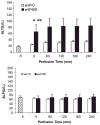Excorporeal normothermic machine perfusion resuscitates pig DCD livers with extended warm ischemia
- PMID: 22099594
- PMCID: PMC3682784
- DOI: 10.1016/j.jss.2011.09.057
Excorporeal normothermic machine perfusion resuscitates pig DCD livers with extended warm ischemia
Abstract
Background: The shortage in donor livers has led to increased use of allografts derived from donation after cardiac death (DCD). The compromised viability in these livers leads to inferior post-transplantation allograft function and survival compared with donation after brain death (DBD) donor grafts. In this study, we reconditioned DCD livers using an optimized normothermic machine perfusion system.
Methods: Livers from 12 Yorkshire pigs (20-30 kg) were subjected to either 0 min (WI-0 group, n = 6) or 60 min (WI-60 group, n = 6) of warm ischemia and 2 h of cold storage in UW solution, followed by 4 h of oxygenated sanguineous normothermic machine perfusion. Liver viability and metabolic function were analyzed hourly.
Results: Warm ischemic livers showed elevated transaminase levels and reduced ATP concentration. After the start of machine perfusion, transaminase levels stabilized and there was recovery of tissue ATP, coinciding with an increase in bile production. These parameters reached comparable levels to the control group after 1 h of machine perfusion. Histology and gross morphology confirmed recovery of the ischemic allografts.
Conclusion: Our data demonstrate that metabolic and functional parameters of livers with extended warm ischemic time (60 min) can be significantly improved using normothermic machine perfusion. We hereby compound the existing body of evidence that machine perfusion is a viable solution for reconditioning marginal organs.
Published by Elsevier Inc.
Figures






Similar articles
-
Improved preservation of warm ischemic livers by hypothermic machine perfusion with supplemented University of Wisconsin solution.J Invest Surg. 2008 Mar-Apr;21(2):83-91. doi: 10.1080/08941930701883657. J Invest Surg. 2008. PMID: 18340625
-
Normothermic extracorporeal liver perfusion for donation after cardiac death (DCD) livers.Surgery. 2015 Dec;158(6):1642-50. doi: 10.1016/j.surg.2015.07.016. Epub 2015 Aug 18. Surgery. 2015. PMID: 26294088
-
One hour hypothermic oxygenated perfusion (HOPE) protects nonviable liver allografts donated after cardiac death.Ann Surg. 2009 Nov;250(5):674-83. doi: 10.1097/SLA.0b013e3181bcb1ee. Ann Surg. 2009. PMID: 19806056
-
Impact of machine perfusion preservation of liver grafts from donation after cardiac death.Transplant Proc. 2014 May;46(4):1099-103. doi: 10.1016/j.transproceed.2013.11.135. Transplant Proc. 2014. PMID: 24815138 Review.
-
A Review of Machine Perfusion Strategies in Liver Transplantation.J Clin Exp Hepatol. 2023 Mar-Apr;13(2):335-349. doi: 10.1016/j.jceh.2022.08.001. Epub 2022 Aug 10. J Clin Exp Hepatol. 2023. PMID: 36950485 Free PMC article. Review.
Cited by
-
Machine Perfusion of Donor Livers for Transplantation: A Proposal for Standardized Nomenclature and Reporting Guidelines.Am J Transplant. 2016 Oct;16(10):2932-2942. doi: 10.1111/ajt.13843. Epub 2016 Jun 13. Am J Transplant. 2016. PMID: 27129409 Free PMC article. Review.
-
Optimization of an in situ liver perfusion method to evaluate hepatic function of juvenile American alligators (Alligator mississippiensis).Biol Open. 2024 Aug 15;13(8):bio060532. doi: 10.1242/bio.060532. Epub 2024 Aug 27. Biol Open. 2024. PMID: 39189399 Free PMC article.
-
Supercooling preservation and transplantation of the rat liver.Nat Protoc. 2015 Mar;10(3):484-94. doi: 10.1038/nprot.2015.011. Epub 2015 Feb 18. Nat Protoc. 2015. PMID: 25692985 Free PMC article.
-
Dual versus single vessel normothermic ex vivo perfusion of rat liver grafts using metamizole for vasodilatation.PLoS One. 2020 Jul 2;15(7):e0235635. doi: 10.1371/journal.pone.0235635. eCollection 2020. PLoS One. 2020. PMID: 32614897 Free PMC article.
-
Functional Implications of Biochemical and Molecular Characteristics of Donation After Circulatory Death Livers.Transplant Direct. 2015 Jun 15;1(5):e18. doi: 10.1097/TXD.0000000000000527. eCollection 2015 Jun. Transplant Direct. 2015. PMID: 27500220 Free PMC article.
References
-
- Wheeldon DR, Potter CD, Oduro A, et al. Transforming the “unacceptable” donor: Outcomes from the adoption of a standardized donor management technique. J Heart Lung Transplant. 1995;14:734. - PubMed
-
- Strasberg SM, Howard TK, Molmenti EP, et al. Selecting the donor liver: Risk factors for poor function after orthotopic liver transplantation. Hepatology. 1994;20(4 Pt 1):829. - PubMed
-
- Kocak Z, Celik Y, Uzal MC, et al. Isolated bilateral sixth nerve palsy secondary to metastatic carcinoma: A case report with a review of the literature. Clin Neurol Neurosurg. 2003;106:51. - PubMed
-
- Chan EY, Olson LC, Kisthard JA, et al. Ischemic cholangiopathy following liver transplantation from donation after cardiac death donors. Liver Transpl. 2008;14:604. - PubMed
Publication types
MeSH terms
Substances
Grants and funding
LinkOut - more resources
Full Text Sources
Other Literature Sources

